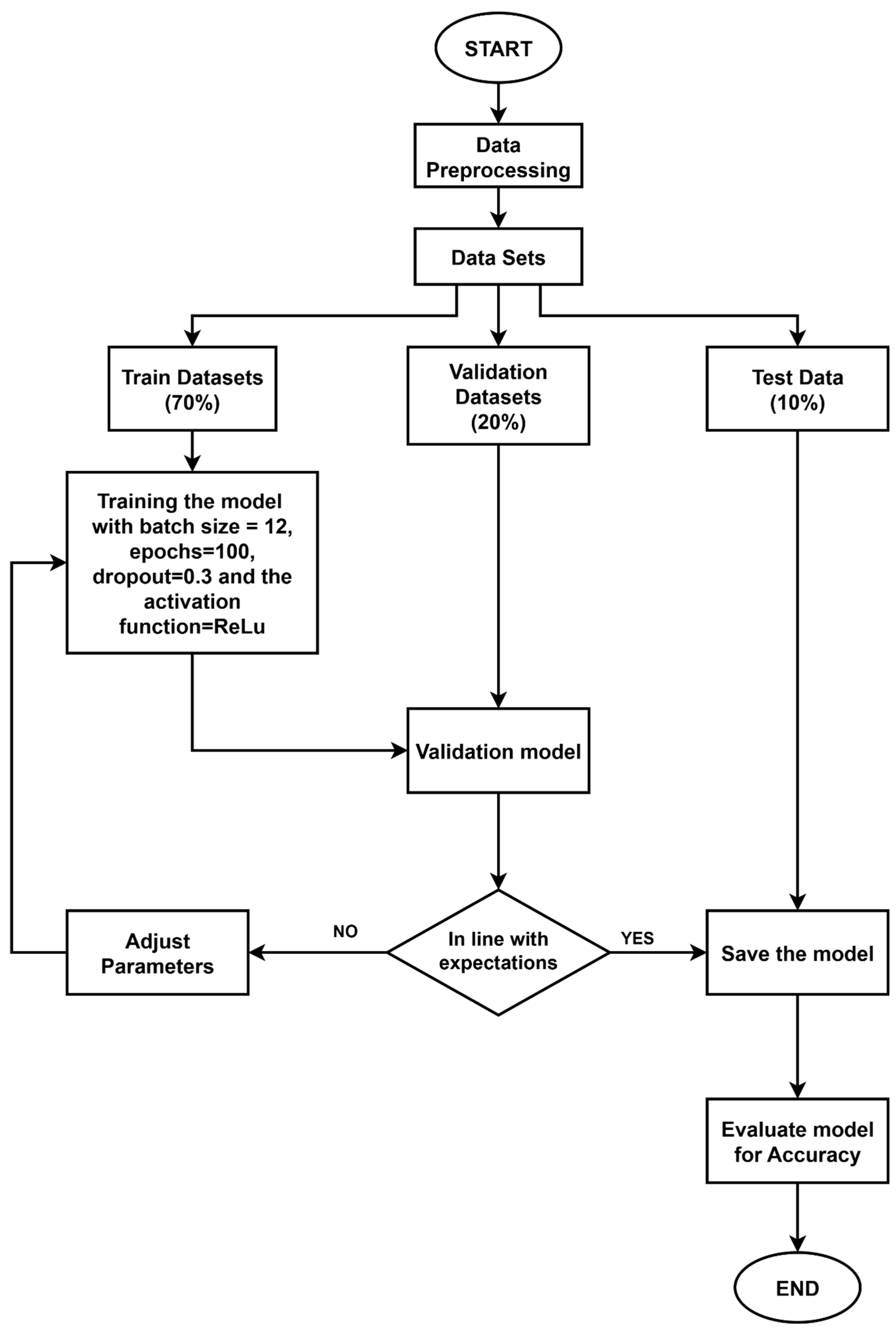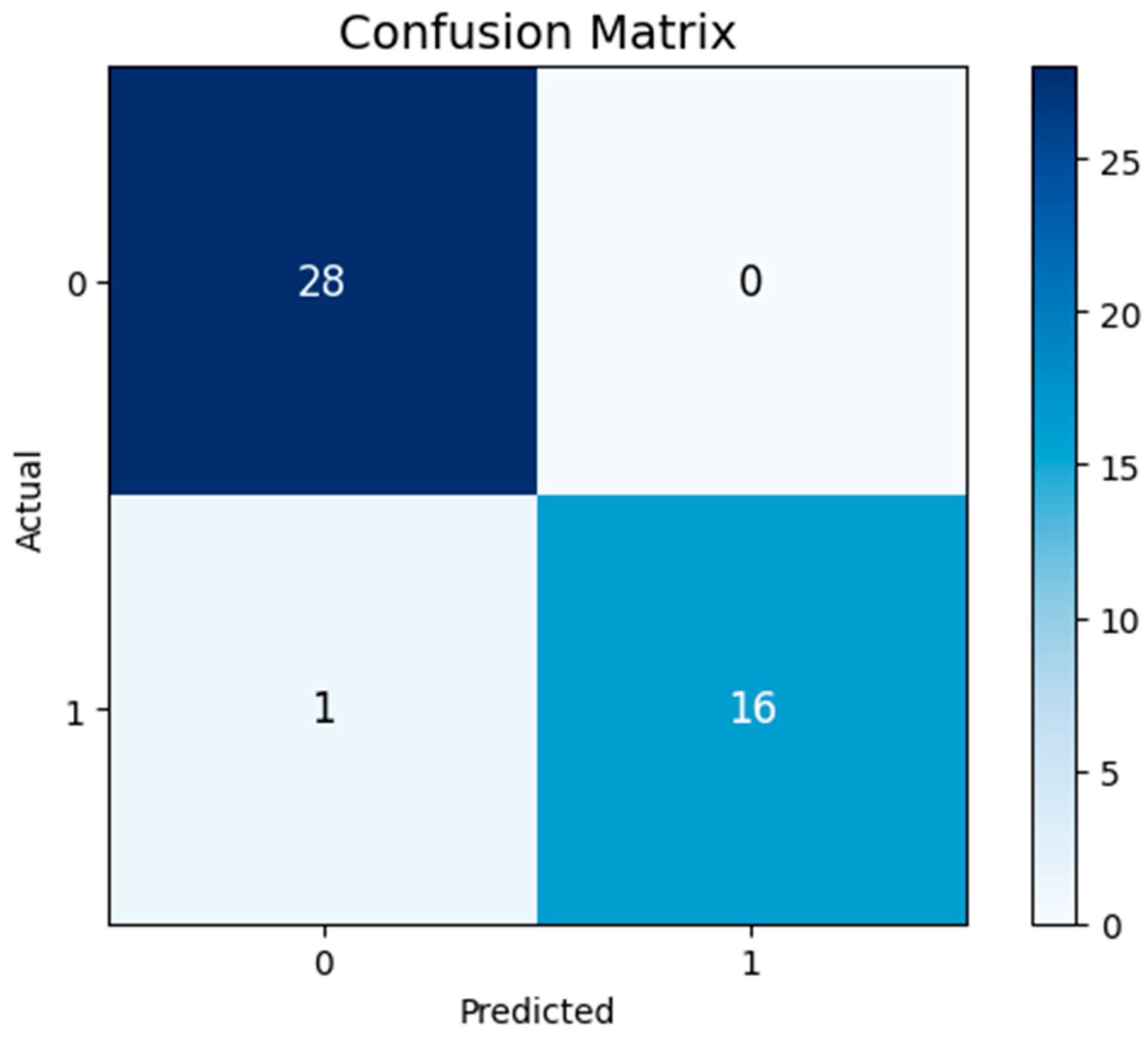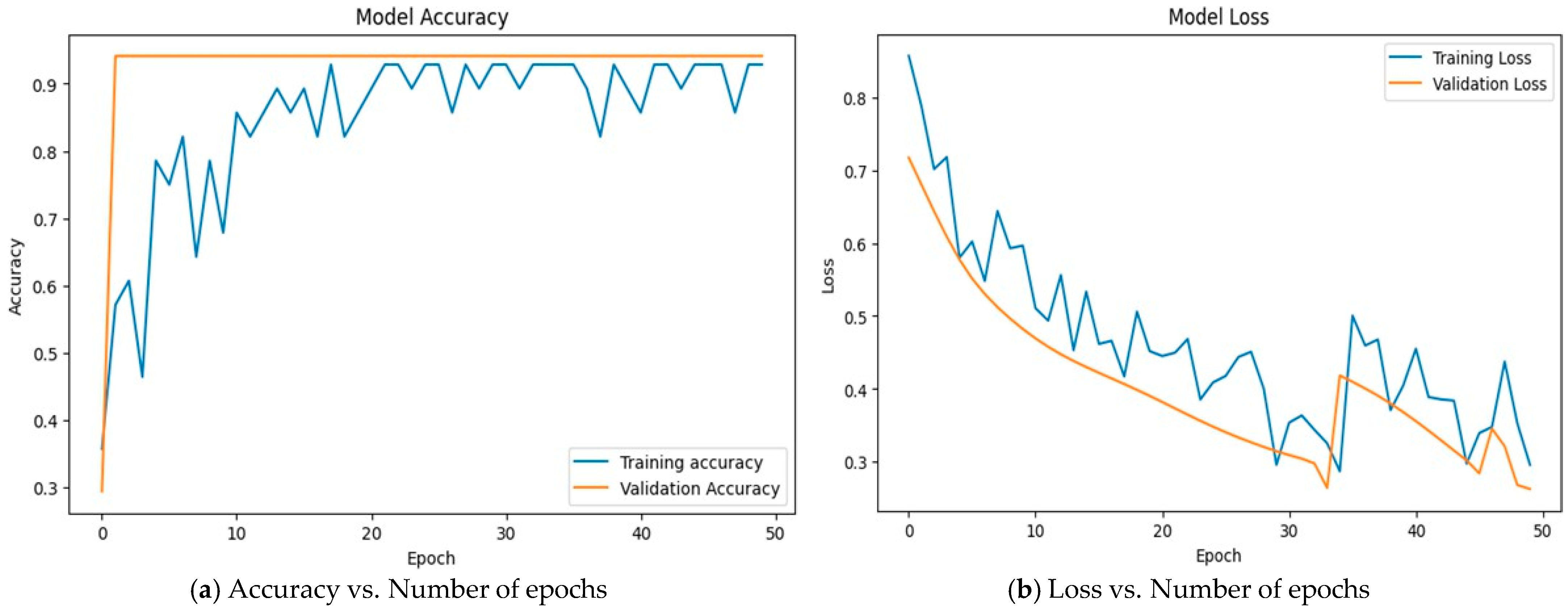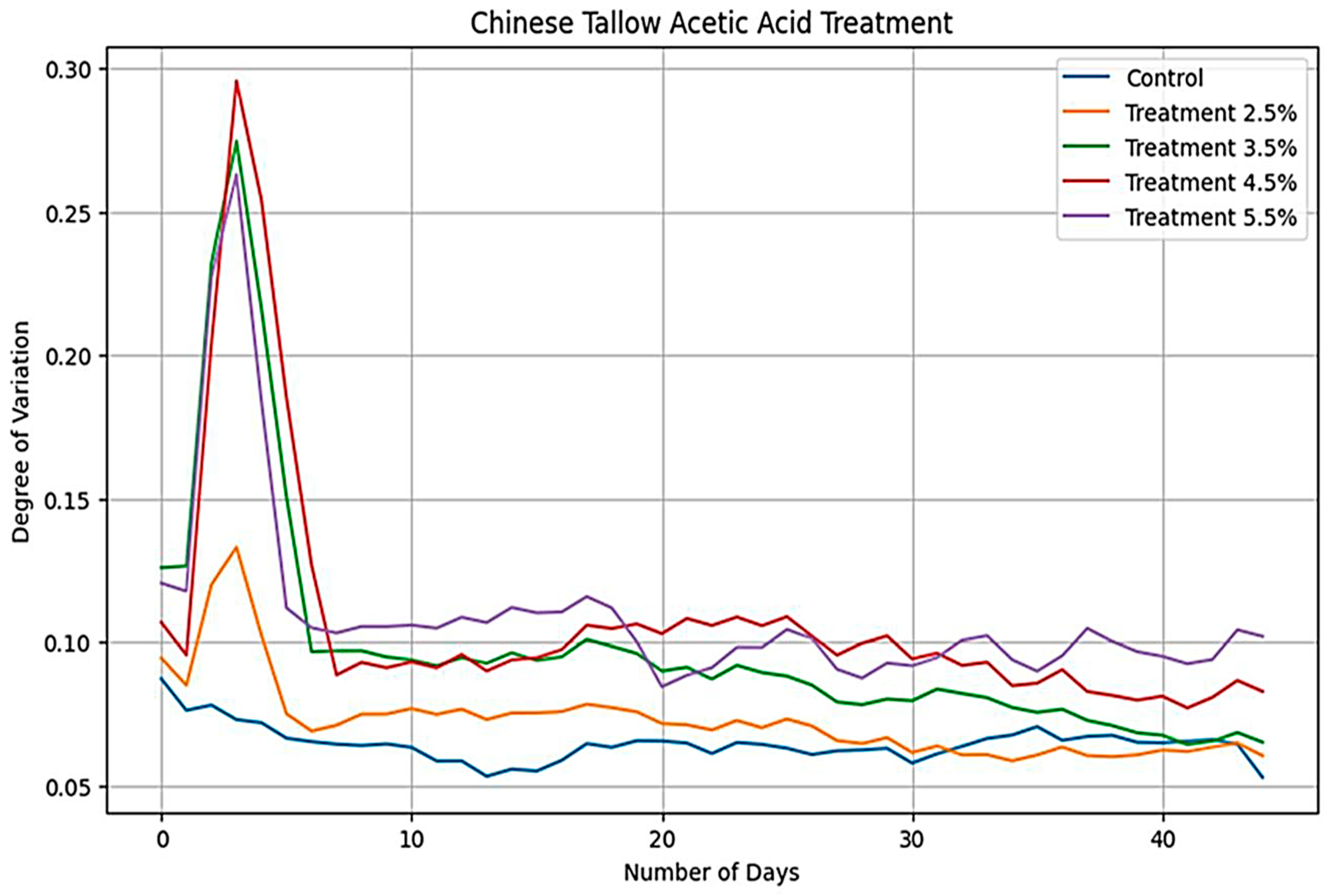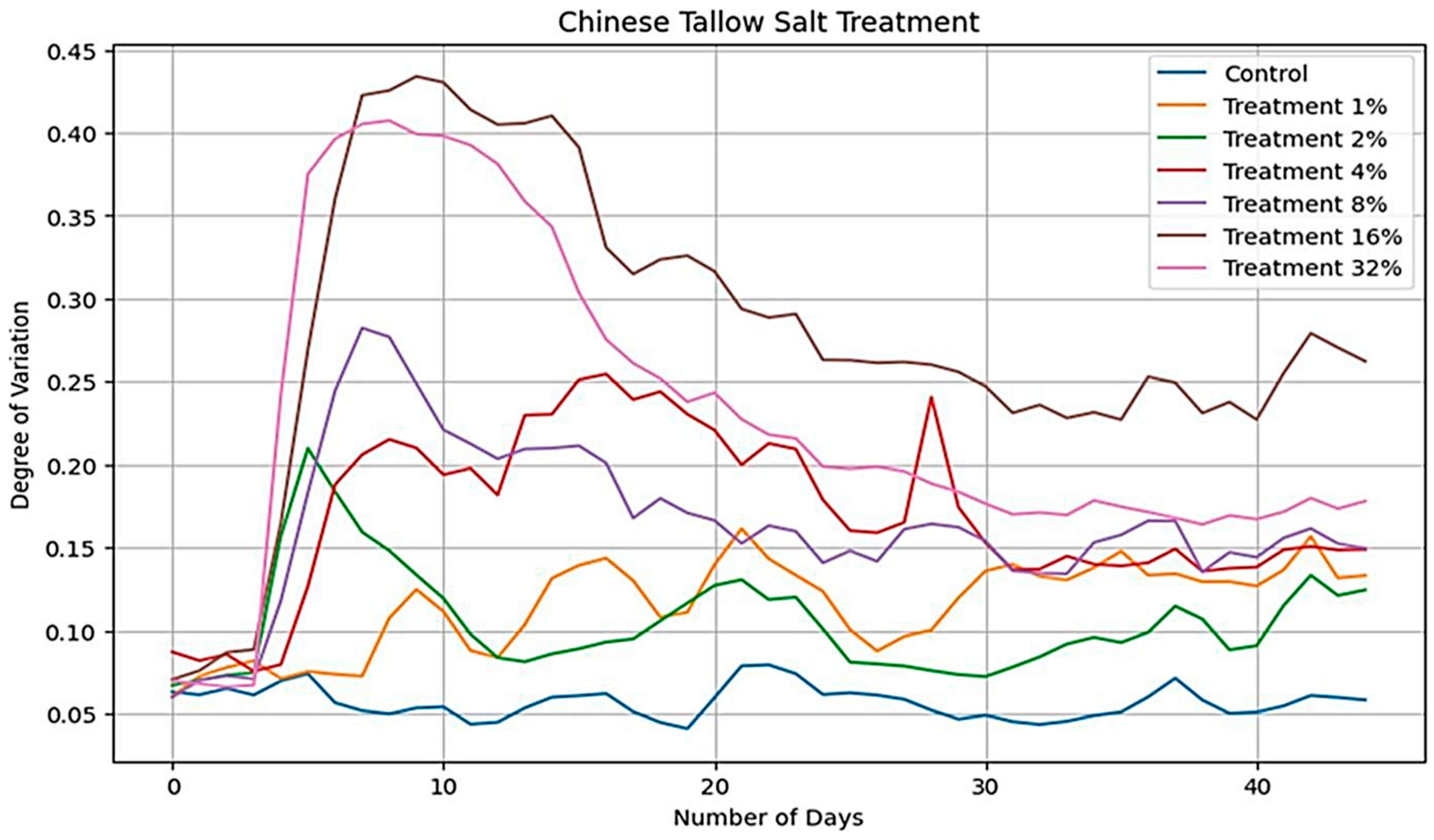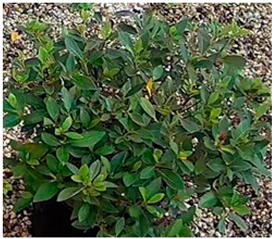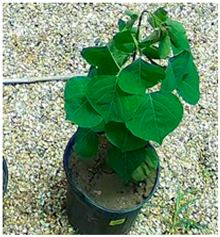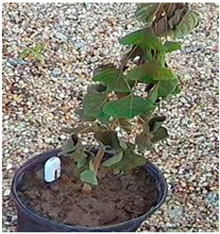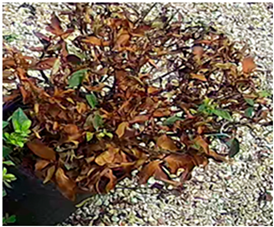1. Introduction
Agriculture is a fundamental industry in society that has a very important task or role in sustaining life. However, the population growth rate is outpacing the production rate of major crops, emphasizing the need for more efficient farming [
1]. Agriculture is a very diverse field that includes cultivating crops, producing livestock, and managing forestry as well as engineering byproducts from these resources. In particular, plants and crops are the foundation of this vital industry [
2]. These resources not only produce fruits, vegetables, and grains but they contribute to healthy ecosystems. Plants and shrubs improve soil fertility and provide food for various wildlife. Additionally, plants absorb carbon dioxide from the atmosphere and thus they help to combat climate change. Thus, by promoting the growth and care of plant life, agriculture can ensure sufficient food production, environmental sustainability, and a healthy balanced ecosystem.
In general, crop productivity, sustainability, and quality are greatly affected by plant and soil health [
3]. Abiotic stress represents a threat to agricultural sustainability and productivity [
4]. Abiotic stressors, such as the presence or absence of certain chemical agents, can negatively impact plant health and/or make them more vulnerable to infections by pathogens like bacteria, viruses, and fungi. When plants encounter abiotic stress and pathogens, the negative effects can lead to reductions in crop yield. As a result, this will cause greater reliance on chemical remedies to hinder these negative effects, which in turn can harm the environment and lead to an increase in production costs. Addressing the impact of abiotic stress on plants is critical for ensuring food security and a robust ecosystem.
One method of enhancing plant health is through chemical treatments. Applying chemical agents to plants can provide benefits, but it can have negative consequences. Fertilizers can provide plants with essential nutrients that enhance growth and yield, while pesticides can protect against pests and diseases. Additionally, chemicals such as stress protectants improve plant tolerance to environmental stress like drought or salinity, and soil conditioners enhance soil structure and nutrient availability. However, excessive or improper use of these agents can lead to nutrient toxicity, soil degradation, pesticide resistance. Depending upon the chemicals that are used, residues can pose health risks to consumers, as well as disrupt ecological balance through soil and water pollution. Therefore, the use of chemical agents can be beneficial in agriculture, but their use must be carefully managed to minimize harm [
5]. Using chemicals in which residue poses no risk to consumers would be ideal.
When used in controlled amounts, sodium chloride and acetic acid have potential benefits for plant health while minimizing the risk to consumers and the ecosystem [
6,
7,
8]. Applying low concentrations of sodium chloride, commonly known as salt, may help plants activate stress response mechanisms and thus increase their tolerance to environmental stresses (such as drought). Additionally, salt may eliminate soil pathogens and thus help prevent disease development in plants. Similarly, applying diluted acetic acid, commonly known as vinegar, may help plant–soil eliminate the growth of weeds (that compete with plants for water and nutrients). Similarly to salt, acetic acid may help suppress plant pathogens and prevent abiotic stress and disease [
7,
9]. Furthermore, acetic acid can also lower soil pH, which may benefit acid thriving plants. However, salt and acetic acid can be harmful if applied in excess [
10,
11]. High concentrations of these chemical agents can damage plant tissues, disrupt nutrient balance, and/or kill beneficial microorganisms [
8].
Determining if a plant has poor health or if its health is at risk due to exposure to abiotic stress is a vital step in solving crop productivity issues. The use of modern computational techniques in the agricultural industry such as machine learning (ML) and data analytics has transformed how plant health problems are detected [
12,
13,
14]. In the past, researchers typically employed direct observation of changes in plants to identify certain diseases since most plant diseases have visible alterations on leaves, stems, or fruits. By using technology such as image processing, machine learning, and deep learning, algorithms have achieved effective, precise detection of various plant diseases. Therefore, these methods seem to be a practical solution that can enable farmers and agriculturist to identify the negative changes that can harm plants.
Recent advances in machine learning have made it possible to collect and analyze large agricultural datasets on plant phenotypes and genotypes [
15]. Research by Rico-Chávez et al. reported that many ML algorithms have been used for modeling plant stress response, but Support Vector Machine (SVM), Random Forest (RF), and Convolutional Neural Networks (CNN) have been the most successful [
16]. Tran et al. applied and tested deep learning, logistic regression, RF, and gradient boost algorithms to assess agricultural health status using electrophysiological sensor data [
17]. They monitored plant responses to water deficit and thus demonstrated the use of sensor data for early stress detection. In another research study, Artificial Neural Network (ANN), Nonlinear Autoregressive Exogenous (NARX) model, and Recurrent Neural Network with Long Short-Term Memory (RNN-LSTM), were compared for their ability to predict temperature, humidity and carbon dioxide in a greenhouse. The results showed that RNN-LSTM model outperformed ANN and NARX models with high accuracy [
18]. Moreover, researchers have also used some of the aforementioned ML models or novel models to analyze and predict soil quality using data from soil sensors or from laboratory measurements [
19,
20,
21]. The reported accuracies from these studies were good in all cases. While a sensor-based approach can provide deeper physiological insight into plant health and environmental insight into soil quality, these results do not provide any visual confirmation that an image-based method can offer.
Many studies have reported on the use of image-based ML algorithms for classifying plant health [
22,
23,
24,
25,
26]. Most of these studies have focused on visual signs for plant disease classification as an indicator of plant health rather than a response to abiotic stress. Thus, this has created a large gap in addressing the broader abiotic stress responses in plants. Furthermore, research demonstrates that multimodal analysis using ML algorithms is a promising approach to analyze plant health [
27,
28,
29,
30]. Again, these studies either focus on disease detection or require expensive equipment and complex time consuming procedures. Using leaf color classification, texture or growth patterns, ML models can identify abnormal visual changes in plants caused by stressors [
31,
32,
33].
Using a multimodal approach to determining plant health in response to abiotic stressors should provide a better understanding of the plant’s condition and what caused any health issues. Research has shown that Residual Network (ResNet) and Long Short-Term Memory (LSTM) machine learning models are good at analyzing images and time series data [
34,
35,
36,
37,
38] and show promise for accurate classification when conditions are not ideal. Thus, based on existing research findings, using ResNet and LSTM machine learning algorithms is a promising multimodal approach to classifying plant health. Applying ResNet for image-based analysis of plants along with LSTM for soil data analysis should provide complementary insights into plants response to external stimuli. Rather than merging these into a single system, the two independent analyses should capture distinct aspects of stress responses and provide a better understanding of how plants respond to external stressors.
Thus, it is understood that abiotic stressors can have positive and negative effects on plant health, and machine learning models can be used to effectively evaluate the effect of those stressors. However, research is lacking on the threshold for these stressors and when they transition from beneficial to harmful. Therefore, the objective of this research study is to use conventional machine learning models to evaluate the effect of chemical agents on plant health and determine how plants respond to abiotic stress. Specifically, various concentrations of salt and acetic acid will be applied to two different plant species, Azalea and Chinese tallow, to determine if these chemical agents cause abiotic stress on the plants. Cameras and soil sensors will record the plants and soil conditions during the experiments. Finally, images from the camera recordings and data from the sensors will be analyzed by ResNet and LSTM machine learning algorithms to classify the condition of plants and their soil. This approach simultaneously deploys ResNet and LSTM architectures to extract interrelated yet distinct information from visual and temporal sensor data and thus leverages the strengths of both neural networks.
4. Discussion
The goal of this research project was to apply abiotic stressors to several types of plants to see what levels of stressors degraded the plant’s health. Moreover, machine learning models were used to determine how accurately they could evaluate and classify the results. Therefore, known and established models were used. These models provided very accurate results (>90%). However, with any study, additional research can always be performed to expand and complement the original study. Additional plant species can be evaluated under the same stimuli. Specifically, different plants can be used, weeds can be evaluated, and crops can also be explored to determine how healthy they are after applying various levels of salt and acetic acid. Moreover, different stimuli can also be evaluated. For example, various abiotic stimuli (such as specific chemicals or different types of radiation) as well as biotic stimuli (such as microbial pathogens) or a combination of these stimuli could be evaluated.
This research study utilizes different machine learning models (ResNet34 and LSTM) on different modes of data (image and sensor) from dual species (tree and shrub) after applying different stressors (salt and acetic acid). Thus, this research is unique and goes beyond published research by using technology to broaden the scope of evaluation and understanding of plant responses to external stimuli across plant types. Although no other study is identical to this study, some meaningful comparisons can be made to results from similar studies [
39,
40,
41,
42,
43].
In a paper by Do et al., images from unmanned aerial vehicles (UAVs) and sensor data from a chlorophyll meter, spectroradiometer, and water potential meter were used to assess citrus plant health through linear regression and a CNN ML models [
39]. Due to the wavelength range of the particular measurements, results show that the ML models are able to predict chlorophyll values better than water potential or normalized difference vegetative index (NDVI). Results also show detection of significant nitrogen and water stress, but root mean square error (RMSE) is reported instead of accuracy, so direct comparisons between those results and results from the current study cannot be made. A research paper by Atanasov et al., utilized a spectrum colorimeter to measure the leaf color, a frequency-domain sensor to measure soil water content, and a soil temperature sensor. The authors used various ML models (Zero Rule, Linear Regression, Locally Weighted Learning, M5P Model Tree, Support Vector Machine, Decision Tree, and Multilayer Perceptron) to assess soil moisture based on leaf color. Of these models, the Decision Tree Regression Model produced the best results for RMSE, but again accuracy was not reported, so a direct comparison is difficult. Results also demonstrate that tomato leaf color is correlated to soil moisture and soil temperature [
40]. Additionally, this research does not use images of the plant but uses a colorimeter and young leaves perform better than older leaves. Studies by Wang et al. and Tian et al., assess plant health through multispectral leaf images [
41,
42]. A multitude of ML algorithms were assessed such as Epsilon-Support Vector Regression (e-SVR), Elastic–Net Regularization Regression (Elastic-Net), Partial Least Squares Regression (PLSR), Random Forest Regression (RF) [
41], as well as Extreme gradient boosting (XGBoost), gradient boosting decision tree (GBDT), random forest (RF), radial basis function neural network (RBFNN) and support vector regression (SVR) [
42]. Although both studies report RMSEs for the models, XGBoost provided an accuracy of 92.9% in assessing plant health from aboveground biomass derived from multispectral images [
41]. It is noted that the accuracy reported herein is higher and it includes soil analysis whereas the results reported by Wang et al., and Tian et al. do not assess soil health [
41,
42]. Finally, a study by Shafi et al., used a multimodal approach to assessing crop health by using multispectral imaging and sensor data (soil temperature, soil moisture, air temperature, air moisture [or humidity]) [
43]. ML models included Naive Bayes (NB), Support Vector Machine (SVM) and seven Neural Networks (NN) with various hyperparameters, hidden layers and activation functions. The results were excellent and 98% accuracy was achieved, but only one plant type was evaluated (wheat crops) and only 2 classification levels were used (instead of 3 levels). Thus, the approach used in the current research project is unique and has great potential to enhance industrial farming applications by integrating early stress alerts systems and management decisions; however, the accuracy of this approach may improve through multimodal ML evaluation.
This research study is step forward in advancing smart automated agriculture. But again, the research is not complete, and additional studies are needed to answer some important questions. Because the datasets were limited for this study, randomization was utilized during the training process to produce more reliable model parameters. As demonstrated, the results were very accurate and acceptable. Additionally, k-fold cross-validation was performed to determine if results could be better. This k-fold analysis reduced accuracy from 0.94 to 0.68. Furthermore, because multispectral image processing can provide data beyond the visible spectrum, it may detect subtle plant changes and thus could be incorporated into the system to enhance performance. Finally, the ResNet and LSTM models (and others) could be integrated into a hybrid or multimodal decision system where results can be synthesized to provide a unified decision support system.
Regarding k-fold cross-validation, research results are mixed. Some researchers report that it performs well [
44], and others demonstrate that it does not [
45]. Additional research reports that there are many factors that can affect performance such as the value of k and the complexity of the data [
46,
47]. Regarding multispectral imaging, there are many papers that demonstrate the benefits of using these types of imaging systems with ML algorithms [
48,
49]. However, the high cost of these systems will limit their use, and additional research is still needed because various factors such as environmental conditions along with spectral and spatial resolution can affect performance [
50,
51]. Finally, regarding multimodal classification, research is showing that this approach is beneficial especially to determine the presence of stress and the reason for that stress [
52,
53]. As promising as this research is, factors such as the type of data (terrestrial images, satellite images, soil sensor data, environmental data, etc.) as well as what type of algorithms (RNN, CNN, DNN) and hybrid model architectures need to be researched to determine these answers [
43,
54,
55,
56].
One objective of this study was to determine if image-based and sensor-based ML models could detect deterioration or decline in plant health. Thus, selecting reliable and trusted ML algorithms was the primary concern rather than testing or evaluating novel architectures. Therefore, the analysis or classification of plant images was performed using a ResNet-34 ML algorithm. Likewise, analysis of IoT soil sensor data was performed using an LSTM ML algorithm. Although there are many neural network architectures that can classify images, ResNet is widely used design and it generally outperforms other CNNs [
57]. As a result, ResNet was chosen for this study. Additionally, there are many ResNet architectures (e.g., ResNet-18 and ResNet-50), but ResNet-34 was selected because of its accuracy and speed (it has more layers than ResNet-18 and thus is more accurate and it has fewer layers than ResNet-50 and thus is faster). Similarly, there are numerous ML algorithms for classification of time series data such as ARIMA and GRU. There are many papers suggesting that LSTM outperforms its counterparts when it comes to forecasting future events [
58,
59] but some research also suggest that LSTM is superior to classical neural networks such as Decision Tree, SVM, Logistic Regression, and K-means [
60].
A collective analysis was carried out on abiotic stressed plants using both ResNet-34 and LSTM models to determine the precision, recall, and F-1 score related to plant health status and soil conditions. These evaluations were performed using the weighted scores in order balance the datasets, as some plant health classes had multiple visual variations. By reporting the weighted scores, the evaluation would provide a fair assessment of the model performance under class imbalance. ResNet-34 achieved weighted scores of 0.96 for precision, recall and F1 score, thereby showing how reliable the model is in performing classification and detection tasks. The precision, recall and F-1 score for LSTM was also very good achieving values of 0.89, 0.94, and 0.91, respectively. These results confirm that both models were effective in capturing physiological changes when all plant classes are weighted. In addition to being accurate, once the models are trained, they are relatively rapid in providing real-time results. The training time for the LSTM model took approximately 7 s and the inference time took approximately 2 msec. The training time for the ResNet34 model took approximately 2.5 h, and the inference time took a maximum of 60 s.
It is noted that during this research, various challenges were encountered. The issues centered on sensor battery failure, sensor noise, plant rooting issues, and variable lighting conditions that affects the video/image quality and usability. For example, the sensor images captured during late hours of the day were too dark or were affected by fluctuating illumination which affected the pixels and color representation of the plants, making it difficult for the model to learn and classify the plants correctly. To help meet the objective of this study, optimal images were applied to the ML model. For the IoT sensors, several cases of electrical instability were observed, where the sensors either stopped reporting a certain parameter or went completely silent for hours within a day. To solve these challenges, more frequent checks and replacements were performed, and multiple redundant sensors were used in each treatment group to ensure reliability. Sections of data with missing reading or lower quality images were removed during preprocessing. However, to provide greater flexibility for the model, and meet real world scenarios, it is better to reduce data preprocessing. This additional research, necessary refinements, and corresponding advances may not only improve model performance and reliability in real world performance but also bring the research closer to practical application and long-term improvements in crop productivity.


